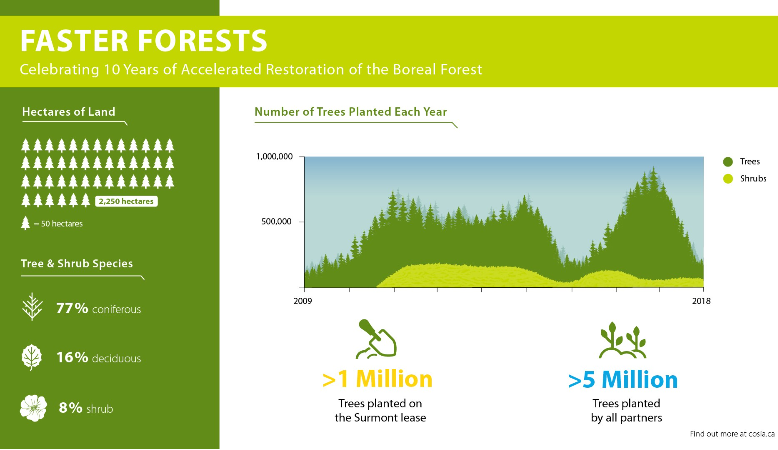5,550 acres restored = more than 4,200 Canadian football fields or 14,200 NHL hockey rinks
Faster Forests, a multiyear effort to accelerate the restoration of Canadian oil sands exploration sites, has planted over 5 million trees and shrubs, on more than 5,550 acres, during the past 10 years. ConocoPhillips Canada (CPC) is celebrating the planting of over 1 million trees and shrubs on our Surmont oil sands lease as part of the program.
A Canada's Oil Sands Innovation Alliance (COSIA) project, Faster Forests is led by CPC and includes an increasing number of industry partners working to accelerate the reclamation of areas impacted by exploration activities. The program has led to the adoption of improvements in site construction and reclamation practices and planting to accelerate site recovery.
“ConocoPhillips has been a leader in the development and broader adoption of the Faster Forests initiative since 2009,” said Kirk Johnson, president, CPC. “We are pleased to reach this milestone and remain committed to continuously improving our practices to ensure we leave behind self-sustaining boreal ecosystems that meet the expectations of our regulators, our Indigenous neighbors and the public.”

Before Faster Forests, historic reclamation practices were rooted in agriculture and often resulted in grassy sites with limited tree and shrub regeneration. Improved construction and reclamation practices, more suited to the boreal forest, protect and enhance the natural capacity of a site to regenerate. These practices preserve diversity and encourage a wide range of plant species to flourish.
“Faster Forests is a great example of how we employ restoration mitigation hierarchy measures when impacts and disturbance cannot be completely avoided or minimized,” said Willie Staudt, director of water and biodiversity for ConocoPhillips.
For example, on upland sites minimal soil disturbance protects roots and encourages speedy natural regeneration. When soils are disturbed, they are placed back in a rough and loose manner, with coarse woody material spread throughout. On lowland or peatland sites, preserving mounds and hollows creates variable water levels to preserve diversity.
After the area is prepared for planting, Faster Forests sites are planted with a mix of coniferous and deciduous trees and shrubs that match the local ecological conditions. The selected plants include species important to local Indigenous communities and the forestry sector. The diversity of species and the care taken to match plants with the site conditions increases the potential for a positive result.

“Through this collaboration with industry, academics and the Alberta Energy Regulator, we have shared successes, learned from failures and captured a decade of insights in technical and visual guides to share with a larger audience,” said Robert Albricht, CPC senior coordinator, environmental projects.
Broad adoption of the Faster Forests techniques increases the resilience of reclaimed sites and accelerates the establishment of forest while reducing overall costs. Ultimately, by applying the principles of Faster Forests at a large scale, we increase reliability of reclamation outcomes and contribute positively to achieving landscape-level ecological benefits.
Read more at cosia.ca.



